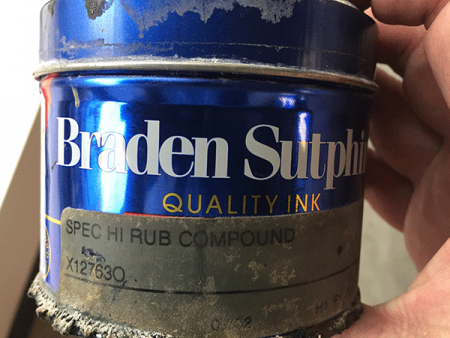Braden Sutphin Spec Hi Rub Compound
Hi, all—
I recently inherited some cans of ink, but one can contains Braden Sutphin’s “Spec Hi Rub Compound.” My instincts tell me this is some sort of varnish, but I haven’t been able to find anything about this specific stuff.
The number “X127630” is on the second line of the label, but nothing has come up using this, either.
I would be grateful for any information you might have on this.
Thanks.
—James

hi_rub_compound.png
You might try contacting Braden Sutphin to see if they can tell you anything. They’re at see.bsink.com
It looks as though*Braden Sutphin* has become part of the >Wikoff Color Corporation< Holding which in turn appear to be Up-Market, High Tech., Hi Spec., in their own right in the Ink, Varnish, & Coatings field.!
IF the seal has been cracked already, perhaps open the can, inspect the waxed/oiled *Keeper* sitting atop the ink itself and with a palette knife or similar remove a minute amount of the colour and do the *DAB* test with the finger tip on decent stock, to ascertain the Colour, preferably in natural light. ?
Could well match up to Pantone or similar color book, which may relate to, or cross reference to, the code on the can,
OR
steam the label of off the can, (without damage) and find the Colour (or otherwise !) under, sometimes on the lid as well.
You may be ahead of the game, by default, Good Luck.
I can’t find any specific detail about this product (Braden Sutphin should have a data sheet, but they are only open to customers on the web, give them a call). I assume it is an ink additive containing either some wax or in more modern cases, a PTFE compound which adds slipperiness to the images so that when used in printing packaging, the items will slip on each other, and not abrade the package underneath. Most likely, you would get a bit more sheen from inks with this additive, but you would not use it where you wish to overprint with another ink color or hot stamping.
I assume the compound has no color or might look like honey or a gray paste in the can. t would take very little of the additive to give the desired result.
I seem to remember that this is an additive for certain types of printing inks before the advent of varnishing and lamination. Some inks were prone to marking by rubbing where the pigment sits on the surface of the paper, especially coated stocks, when the vehicle has been adsorbed to quickly leaving the pigment on the surface.
The additive was used to overcome this problem.
Thanks to all for your answers.
I will do the dab test (along with contacting Braden Sutphin) and let you know what I find out.
—JQ